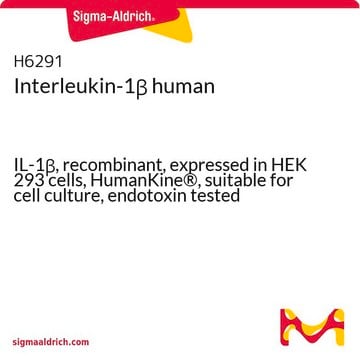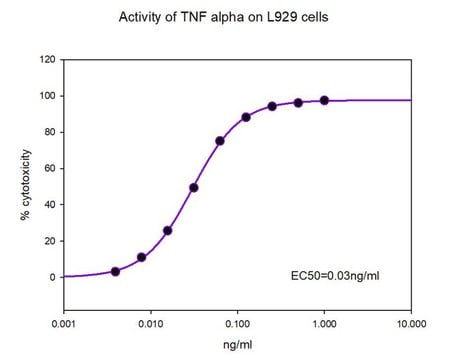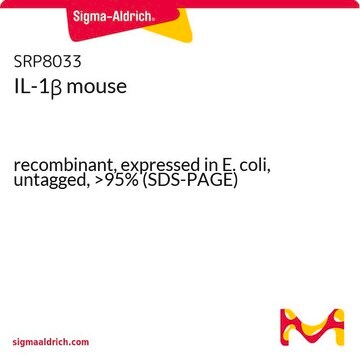IL038
Interleukin-1β Protein, Recombinant human
The recombinant human Interleukin-1beta protein (or IL-1beta protein) is a potent immuno-modulator which mediates a wide range of immune & inflammatory responses including the activation of B & T-cells.
Synonym(s):
IL-1beta
Sign Into View Organizational & Contract Pricing
All Photos(1)
About This Item
UNSPSC Code:
12352202
eCl@ss:
32160405
NACRES:
NA.75
Recommended Products
biological source
human
Quality Level
Assay
>98% (SDS-PAGE and HPLC)
specific activity
>1 x 10e9 U/mg
manufacturer/tradename
Chemicon®
technique(s)
cell culture | mammalian: suitable
impurities
<0.1 ng/μg endotoxin (of human IL-1beta; 1EU/μg)
input
sample type hematopoietic stem cell(s)
NCBI accession no.
UniProt accession no.
shipped in
dry ice
General description
Interleukin-1beta (IL-1beta) is a potent immuno-modulator which mediates a wide range of immune and inflammatory responses including the activation of B and T-cells. Human IL-1beta is a 17.3 kDa protein containing 153 amino acid residues.
Application
For most in vitro applications, human IL-1beta is fully biological activity in the concentration range of 0.1 to 10.0 ng/mL. Responding cells are (partial list): Leukocytes.
Physical form
Sterile filtered and lyophilized from 10 mM Tris, pH 8.2 with no preservatives.
Storage and Stability
The lyophilized human IL-1beta, though stable at room temperature, is best stored desiccated at -20°C. After a quick spin, reconstitute in water to a concentration of 0.1-1.0 mg/mL. This solution can be diluted into other buffered solutions. Reconstituted human IL-1beta should be stored in undiluted aliquots at -20°C for up to six months.
Analysis Note
Specific Activity: Chemicon′s human IL-1beta is fully biologically active when compared to standards.The ED(50) as determined by the dose-dependent stimulation of the proliferation of murine D10S cells is <0.001 ng/mL
Legal Information
CHEMICON is a registered trademark of Merck KGaA, Darmstadt, Germany
Disclaimer
Unless otherwise stated in our catalog or other company documentation accompanying the product(s), our products are intended for research use only and are not to be used for any other purpose, which includes but is not limited to, unauthorized commercial uses, in vitro diagnostic uses, ex vivo or in vivo therapeutic uses or any type of consumption or application to humans or animals.
Storage Class Code
11 - Combustible Solids
WGK
WGK 1
Certificates of Analysis (COA)
Search for Certificates of Analysis (COA) by entering the products Lot/Batch Number. Lot and Batch Numbers can be found on a product’s label following the words ‘Lot’ or ‘Batch’.
Already Own This Product?
Find documentation for the products that you have recently purchased in the Document Library.
Customers Also Viewed
Lijun Zhu et al.
Cells, 11(10) (2022-05-29)
Toxoplasma gondii is a common opportunistic protozoan pathogen that can parasitize the karyocytes of humans and virtually all other warm-blooded animals. In the host's innate immune response to T. gondii infection, inflammasomes can mediate the maturation of pro-IL-1β and pro-IL-18
Monika E Czerwińska et al.
Plants (Basel, Switzerland), 10(11) (2021-11-28)
Fruits of Cornus mas and Cornus officinalis are representative plant materials traditionally used in Europe and Asia, respectively, in the treatment of diabetes and diabetes-related complications, which are often mediated by pathogenic inflammatory agents. Additionally, due to the fact of
Byounghoon Brian Hwang et al.
Communications biology, 3, 8-8 (2020-01-08)
Monitoring cellular signaling events can help better understand cell behavior in health and disease. Traditional immunoassays to study proteins involved in signaling can be tedious, require multiple steps, and are not easily adaptable to high throughput screening (HTS). Here, we
Osteoarthritic chondrocytes undergo a glycolysis-related metabolic switch upon exposure to IL-1b or TNF.
Defois, et al.
Cell communication and signaling : CCS, 21, 137-137 (2023)
Rojo A Ratsimandresy et al.
Nature communications, 8, 15556-15556 (2017-06-06)
Inflammasomes are protein platforms linking recognition of microbe, pathogen-associated and damage-associated molecular patterns by cytosolic sensory proteins to caspase-1 activation. Caspase-1 promotes pyroptotic cell death and the maturation and secretion of interleukin (IL)-1β and IL-18, which trigger inflammatory responses to
Our team of scientists has experience in all areas of research including Life Science, Material Science, Chemical Synthesis, Chromatography, Analytical and many others.
Contact Technical Service









